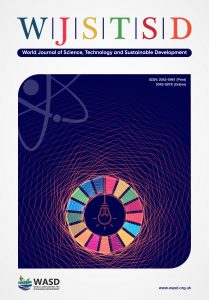Dynamic relationship between embodied and operational impacts of buildings: An evaluation of sustainable design appraisal tools, Saheed Ajayi, Prof. Lukumon Oyedele and Jamiu Dauda
 Saheed O. Ajayi
Saheed O. Ajayi
School of Built Environment and Engineering
Leeds Beckett University, Leeds
UK
Email: arcileogbo@outlook.com
Prof. Lukumon O. Oyedele
Bristol Enterprise, Research and Innovation Centre (BERIC)
University of West of England, Bristol
UK
Jamiu A. Dauda
School of Civil Engineering
University of Leeds, Leeds
UK
DOI: 10.1108/WJSTSD-05-2018-0048
Purpose: Buildings and their construction activities consume a significant proportion of mineral resources excavated from nature and contribute a large percentage of CO2 in the atmosphere. As a way of improving the sustainability of building construction and operation, various sustainable design appraisal standards have been developed across nations. Albeit criticism of the appraisal standards, evidence shows that increasing sustainability of the built environment has been engendered by such appraisal tools as Building Research Establishment Environmental Assessment Method (BREEAM), Code for Sustainable Homes (CfSH), Leadership in Energy and Environmental Design and Comprehensive Assessment System for Built Environment Efficacy, among others. The purpose of this paper is to evaluate the effectiveness of the appraisal standards in engendering whole lifecycle environmental sustainability of the built environment.
Design/methodology/approach: In order to evaluate the adequacy of sustainability scores assigned to various lifecycle stages of buildings in the appraisal standards, four case studies of a block of classroom were modelled. Using Revit as a modelling platform, stage by stage lifecycle environmental impacts of the building were simulated through Green Building Studio and ATHENA Impact estimator. The resulting environmental impacts were then compared against the assessment score associated with each stage of building lifecycle in BREAAM and CfSH.
Findings: Results show that albeit the consensus that the appraisal standards engender sustainability practices in the AEC industry, total scores assigned to impacts at each stage of building lifecycle is disproportionate to the simulated whole-life environmental impacts associated with the stages in some instances.
Originality/value: As the study reveals both strengths and weaknesses in the existing sustainability appraisal standards, measures through which they can be tailored to resource efficiency and lifecycle environmental sustainability of the built environment are suggested.
Keywords: Sustainability; Construction; Circular economy.
Citation: Ajayi, S.O., Oyedele, L.O. and Dauda, J.A. (2019), "Dynamic relationship between embodied and operational impacts of buildings: An evaluation of sustainable design appraisal tools", World Journal of Science, Technology and Sustainable Development, Vol. 16 No. 2, pp. 70-81. https://doi.org/10.1108/WJSTSD-05-2018-0048

